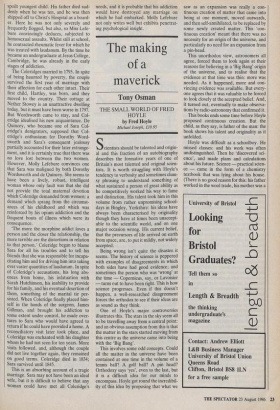Home life
with an addict
Anthony Storr
THE BONDAGE OF LOVE: A LIFE OF MRS SAMUEL TAYLOR COLERIDGE by Molly Lefebure
Gollancz, £15.95
Twelve years ago I reviewed Molly Lefebure's Samuel Taylor Coleridge: A Bondage of Opium (Gollancz, 1974) with enthusiasm. The author is not only a literary scholar, but also has specialised knowledge of drug addiction. Her new book extends our understanding of the Coleridge family and friends, and is espe- cially concerned with rehabilitating the reputation of Sara Coleridge, whom Miss Lefebure rates 'among the most maligned of great men's wives'. Although Sara Col- eridge tried to protect her husband's repu- tation by destroying his letters to her, as well as much of his other correspondence, some 150 of her own letters have never been published, and these have been ex- tensively drawn upon by Miss Lefebure.
Sara Fricker was born in 1770, the eldest of six surviving children of Stephen and Martha Fricker. Her father first went bankrupt and then died when she was 16. The family were closely involved with the Southeys. Robert Southey not only married Sara's younger sister, Edith, but was re- sponsible for introducing her to Coleridge, with whom she promptly fell in love. Molly Lefebure probably knows as much or more about the Coleridge family as she does about her own. Her long familiarity with her subject has made her able to depict not only the principal characters but also their social and family milieux in so convincing a way that one feels one must have known them.
The marriages of highly creative people are often fraught with difficulty. Not every spouse is self-effacing enough to tolerate the fact that, for such people, personal relationships take second place to work. Coleridge would have been a difficult husband even if he had not been an opium addict. For his first seven years, he was a spoilt youngest child. His father died sud- denly when he was ten, and he was then shipped off to Christ's Hospital as a board- er. Here he was not only severely and frequently flogged, but also, so Miss Lefe- bure convincingly deduces, subjected to homosexual assaults. Whilst still at school, he contracted rheumatic fever for which he was treated with laudanum. By the time he became an undergraduate at Jesus College, Cambridge, he was already in the early stages of addiction.
The Coleridges married in 1795. In spite of being haunted by poverty, the couple survived the first year of marriage with their affection for each other intact. Their first child, Hartley, was born, and they moved to the country. Their cottage at Nether Stowey is an unattractive dwelling today, but it must have been worse in 1797. But Wordsworth came to stay, and Col- eridge idealised his new acquaintance. De Quincey, who became one of Sara Col- eridge's denigrators, supposed that Col- eridge's enthusiasm for Dorothy Word- sworth and Sara's consequent jealousy partially accounted for their later estrange- ment, and it is certainly true that there was no love lost between the two women. However, Molly Lefebure convinces one that Sara was maligned by both Dorothy Wordsworth and de Quincey. She seems to have been a lively, robust, intelligent woman whose only fault was that she did not provide the total maternal devotion which Coleridge demanded from women: a demand which sprang from the circumst- ances of his childhood and which was reinforced by his opium addiction and the frequent bouts of illness which were its consequence.
`The more the morphine addict loves a person and the closer the relationship, the more terrible are the distortions in relation to that person.' Coleridge began to blame Sara for all his troubles and to tell his friends that she was responsible for incapa- citating him and for driving him into taking ever vaster quantities of laudanum. In spite of Coleridge's accusations, his long abs- ences from home, his infatuation with Sarah Hutchinson, his inability to provide for his family, and his eventual desertion of them, something of the marital tie per- sisted. When Coleridge finally placed him- self in the hands of the surgeon, James Gillman, and brought his addiction to some extent under control, he made over- tures to Sara who would have agreed to return if he could have provided a home. A reconciliatory visit later took place, and Coleridge was enchanted with his daughter whom he had not seen for ten years. More visits followed, and, although the couple did not live together again, they remained on good terms. Coleridge died in 1834; Sara survived until 1845.
This is an absorbing account of a tragic marriage. Sara may not have been an ideal wife, but it is difficult to believe that any woman could have met all Coleridge's needs, and it is probable that his addiction would have destroyed any marriage on which he had embarked. Molly Lefebure not only writes well but exhibits penetrat- ing psychological insight.











































 Previous page
Previous page